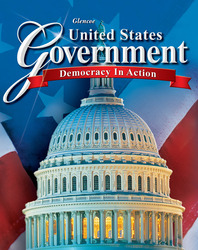
United States Government: Democracy in ActionChapter 3: The ConstitutionChapter Overviews[logo] Essential Question Section 1 Structure and Principles Section 2 Three Branches of Government The Founders recognized the need for a strong executive to carry out the acts of Congress. The Constitution grants the president broad but rather vague powers. Specific powers include functioning as commander in chief of the armed forces and state militias; appointing heads of executive departments, ambassadors, and federal judges with the consent of the Senate; making treaties with foreign nations with the Senate's advice and consent; and meeting heads of state. A federal bureaucracy helps the president “faithfully execute” the laws passed by Congress. The American judiciary is made up of two different court systems. The federal court system derives its power from the Constitution and federal laws. The 50 state court systems derive power from the various state constitutions and laws. Federal court jurisdiction is limited by the subject matter of the case and parties involved in a case. Federal courts try cases that involve federal laws, foreign treaties, international law, bankruptcy cases, and interpretations of the Constitution. The principle of separation of powers intends that there will be some conflict among the three branches of government as a way to ensure liberty. Section 3 Amending the Constitution Amending the Constitution is a direct method of adapting the document to modern times. But the Constitution can also be adapted in a number of indirect ways. Congress can affect interpretation of the Constitution by changing laws or using its other powers. The president, too, adjusts the interpretation of the Constitution through actions such as conducting foreign affairs through executive agreement and aggressively requesting legislation from Congress. Through its power of judicial review, the Supreme Court plays a key role in interpreting the Constitution, either by practicing judicial restraint or supporting judicial activism. Section 4 The Amendments The Sixth Amendment guarantees additional rights to the accused: to have a speedy and public trial by an impartial jury, to hear and question witnesses, and to be defended by a lawyer. The Seventh Amendment assures the right to a jury trial in civil cases. The Eighth Amendment protects against excessive bail and cruel and unusual punishment. The Ninth Amendment provides that people's rights are not restricted to those specified in Amendments 1 through 8. The Tenth Amendment restates that any powers not granted to the federal government nor prohibited to the states are reserved to the states and to the people. The Civil War Amendments—Thirteen, Fourteen, and Fifteen—were the result of that conflict. The Thirteenth Amendment outlawed slavery. The Fourteenth Amendment, similar to the Fifth Amendment, prohibits a state from depriving a person of life, liberty, or property without due process of law. The Fifteenth Amendment prohibits the government from denying a person's right to vote on the basis of race. The later amendments (Sixteen through Twenty-seven) were added in the twentieth century. They deal with a range of topics that reflect some of the changes that occurred in American society during that period—advances in the status of workers, African Americans, and women to mention a few. |  |















